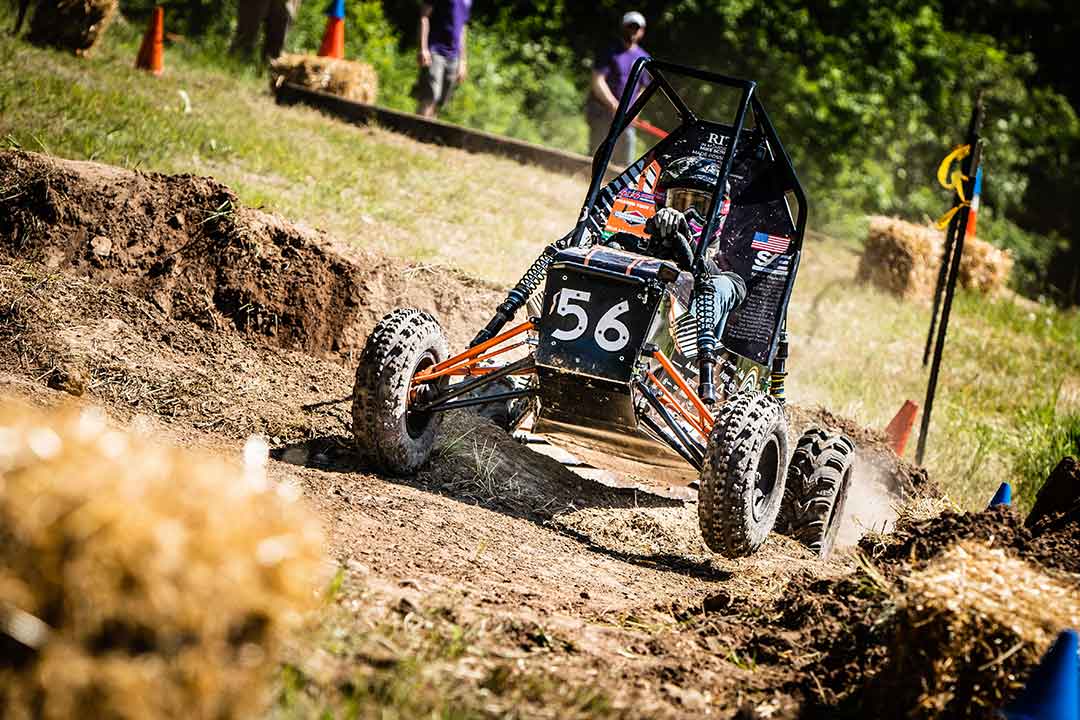RIOT Racing: Baja team wins first place overall in weekend international competition
RIT’s team takes top placement at hometown event for the first time in its seven previous outings
Scott Hamilton
RIOT Racing, RIT’s Baja race team, took first place overall at the Baja SAE Rochester Challenge. It was the first time the team won “at home” since it began hosting the international event. This year marked the university’s seventh time as host. Click through to see more photos from the event.
The suspension track, a twisting course of multiple railroad ties, boulders, and a treacherous curve that saw more cars upside down than upright, proved to be the biggest tests at this past weekend’s Baja SAE Rochester Challenge.
Photo gallery
Click through the top image to see more photos from the weekend's events.
Several teams aced the course, but at the end of the weekend, RIOT Racing, Rochester Institute of Technology’s Baja race team, conquered the field. Of the previous seven times hosting the Rochester event, this was the first year RIT took home the big trophy.
Rounding out the top finishers for the multi-day event were: RIT, the University of Michigan Ann Arbor, Ecole de Technologie Superieure (Canada), Cornell University, and Purdue University – West Lafayette.
More than 1,500 students from 100 national and international collegiate race teams competed June 2-5 at RIT’s Gordon Field House and the Hogback Hill Motocross site in Palmyra, N.Y. Sponsored by SAE International, the student design competition tested students’ engineering skills. It was also an opportunity for companies to find talented engineers.
Overall Baja SAE Challenge Event Winners
- Rochester Institute of Technology
- University of Michigan Ann Arbor
- Ecole de Technologie Superieure (Canada)
- Cornell University
- Purdue University – West Lafayette
- University of Wisconsin – Madison
- Concordia University
- San Diego State University
- University of Nevada - Las Vegas
- McMaster University (Canada)
During the spring semester, RIOT Racing met regularly to build its car, participating in system and equipment reviews and making decisions based on what’s best for the team and the competition, said Mike Borodzik, project manager for RIOT Racing.
“We did what we set out to do this year,” said the fourth-year mechanical engineering major from Depew, N.Y. “A lot of time and dedication was put into this car. It is not something that is slapped together and you just run with it. There’s a lot more to it; some sacrifice sleep to get this car made.”
The approach worked as RIT placed fifth in the cost category, 10th in acceleration, fourth in the sled pull, and 14th in maneuverability, as well as first in overall dynamics, the field-based challenges. With third place in endurance—contributing major points toward an overall score—and second in suspension, RIT came out on top.
Cornell won the acceleration event and had the fastest lap time in the 4-hour endurance race in 3:41. Ecole de Superieure would take top placements in acceleration, maneuverability, and design.
Rochester-based event planners have a reputation for building a track that tests cars, and historically, the suspension event is a challenge and a crowd-pleaser.
“Our original design was even more difficult,” said Asif Habib ’20 (mechanical engineering technology) who helped prepare the field.
“We knew it may knock the cars around a bit, but the course tests what they built. There was enough variance to the course to see how the cars would move through it,” said Habib, a former RIT Baja team member and now a mechanical engineer with Anduril Industries, based in Irvine, Calif. “More cars finished than expected. It was a great event.”
Corporate sponsors such as Polaris and Honda have been involved for many years with SAE collegiate events and provide financial support as well as volunteers with engineering automotive design experience. Among the many sponsors of the major national collegiate design challenge, Cummins Inc. representatives participated in multiple facets of the event as sales and design judges and course safety and engine/system inspectors. Students also met with representatives to learn more about positions with the company as interns and as employees.
“We look for people that can communicate well and really show a drive and passion for this work,” said Mariah Plants, a production validation engineer. “At Cummins, we are constantly innovating and need passionate and diverse thinkers to design and build the products of the future that can help us reach our zero emissions goal. There are many talented individuals here who demonstrate the spirit of innovation and who would likely enjoy a challenging and rewarding career at Cummins.” Cummins Inc. specializes in diesel and alternative fuel engines and power generation products. “This event is a very good indicator to us of their passion and what they did to build, test, and compete with their cars,” she said.
Plants spoke with more than 100 students at the event and also had an eye out for her former teammates on Penn State-Altoona’s Baja team.
The last time RIT hosted an SAE Baja event was in 2019 just before the pandemic. Over the previous two years, onsite field events had to be curtailed, with only virtual design presentations by student teams. In 2022, SAE began onsite challenges once again, and Rochester was the second of its three U.S.-based Baja series events. Baja SAE Arizona takes place in September.
“Planning takes about a year to put it all in place — from logistics to site development — and the thinking is, ‘it’s three years away, we have time.’ But then everything changed after 2019,” said Martin Gordon, RIT team academic adviser and professor in RIT’s College of Engineering Technology. “Think of what happened between 2019 and now. This has been a great competition, and we’re happy to be back together. We’re looking forward to 2025.”













